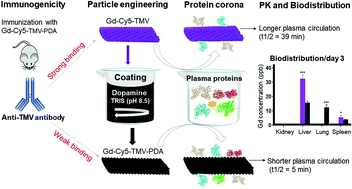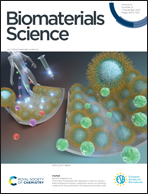The in vivo fate of tobacco mosaic virus nanoparticle theranostic agents modified by the addition of a polydopamine coat†
Abstract
Plant virus nanoparticles (VNPs) have multiple advantages over their synthetic counterparts including the cost-effective large-scale manufacturing of uniform particles that are easy to functionalize. Tobacco mosaic virus (TMV) is one of the most promising VNP scaffolds, reflecting its high aspect ratio and ability to carry and/or display multivalent therapeutic ligands and contrast agents. Here we investigated the circulation, protein corona, immunogenicity, and organ distribution/clearance of TMV particles internally co-labeled with cyanine 5 (Cy5) and chelated gadolinium (Gd) for dual tracking by fluorescence imaging and optical emission spectrometry, with or without an external coating of polydopamine (PDA) to confer photothermal and photoacoustic capabilities. The PDA-coated particles (Gd-Cy5-TMV-PDA) showed a shorter plasma circulation time and broader distribution to organs of the reticuloendothelial system (liver, lungs, and spleen) than uncoated Gd-Cy5-TMV particles (liver and spleen only). The Gd-Cy5-TMV-PDA particles were surrounded by 2–10-fold greater protein corona (containing mainly immunoglobulins) compared to Gd-Cy5-TMV particles. However, the enzyme-linked immunosorbent assay (ELISA) revealed that PDA-coated particles bind 2-fold lesser to anti-TMV antibodies elicited by particle injection than uncoated particles, suggesting that the PDA coat enables evasion from systemic antibody surveillance. Gd-Cy5-TMV-PDA particles were cleared from organs after 8 days compared to 5 days for the uncoated particles. The slower tissue clearance of the coated particles makes them ideal for theranostic applications by facilitating sustained local delivery in addition to multimodal imaging and photothermal capabilities. We have demonstrated the potential of PDA-coated proteinaceous nanoparticles for multiple biomedical applications.



 Please wait while we load your content...
Please wait while we load your content...